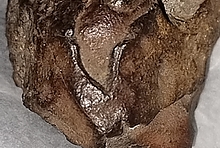Home PageAbout MindatThe Mindat ManualHistory of MindatCopyright StatusWho We AreContact UsAdvertise on Mindat
Donate to MindatCorporate SponsorshipSponsor a PageSponsored PagesMindat AdvertisersAdvertise on Mindat
Learning CenterWhat is a mineral?The most common minerals on earthInformation for EducatorsMindat ArticlesThe ElementsThe Rock H. Currier Digital LibraryGeologic Time
Minerals by PropertiesMinerals by ChemistryAdvanced Locality SearchRandom MineralRandom LocalitySearch by minIDLocalities Near MeSearch ArticlesSearch GlossaryMore Search Options
The Mindat ManualAdd a New PhotoRate PhotosLocality Edit ReportCoordinate Completion ReportAdd Glossary Item
Mining CompaniesStatisticsUsersMineral MuseumsClubs & OrganizationsMineral Shows & EventsThe Mindat DirectoryDevice SettingsThe Mineral Quiz
Photo SearchPhoto GalleriesSearch by ColorNew Photos TodayNew Photos YesterdayMembers' Photo GalleriesPast Photo of the Day GalleryPhotography
╳Discussions
💬 Home🔎 Search📅 LatestGroups
EducationOpen discussion area.Fakes & FraudsOpen discussion area.Field CollectingOpen discussion area.FossilsOpen discussion area.Gems and GemologyOpen discussion area.GeneralOpen discussion area.How to ContributeOpen discussion area.Identity HelpOpen discussion area.Improving Mindat.orgOpen discussion area.LocalitiesOpen discussion area.Lost and Stolen SpecimensOpen discussion area.MarketplaceOpen discussion area.MeteoritesOpen discussion area.Mindat ProductsOpen discussion area.Mineral ExchangesOpen discussion area.Mineral PhotographyOpen discussion area.Mineral ShowsOpen discussion area.Mineralogical ClassificationOpen discussion area.Mineralogy CourseOpen discussion area.MineralsOpen discussion area.Minerals and MuseumsOpen discussion area.PhotosOpen discussion area.Techniques for CollectorsOpen discussion area.The Rock H. Currier Digital LibraryOpen discussion area.UV MineralsOpen discussion area.Recent Images in Discussions
Identity HelpCalcite ID in stones in Santa Rosa CA creek

26th Mar 2024 23:57 UTCPaul Hernday
I'm finding that my hunch is pretty good at visually distinguishing calcite from quartzite prior to the acid test, but I'm not sure why. Maybe it's the context of the type or shape of rock, or the flatter white of the calcite or ??? Any signs others have noticed?
Questions Answered
Can it scratch glass? : No
Can you scratch it with your fingernail? : No
Is it light/heavy for the size? : Normal
27th Mar 2024 01:20 UTCJohn Christian

27th Mar 2024 03:12 UTCPaul Hernday

27th Mar 2024 05:21 UTCHenry Raab
27th Mar 2024 06:06 UTCJohn Christian
Newer rocks were fractured by the earthquakes caused by the plate motion and then filled with calcite.
See if the calcite veins are fluorescent.

27th Mar 2024 13:57 UTCEd Clopton 🌟 Expert
29th Mar 2024 14:38 UTCGregg Little 🌟
Ed Clopton 🌟 Expert ✉️
mineral quartz that started out as sandstone, which in turn started out as quartz sand. Ed; I couldn't resist going further down your technical rabbit hole so do forgive me. The word "sandstone" in this case should be replaced with "quartz arenite". The term sandstone is actually a detrital rock grain-size term (1/16 to 2 mm) where the clasts could be any mineral or lithic fragment. Virtually everyone assumes it is mineralogically a quartz sand which is usually accurate, sort of by default as quartz being highly resistant usually is the last mineral standing in the erosional processes.

29th Mar 2024 15:52 UTCEd Clopton 🌟 Expert
Arenite must derive from the Latin arena for sand, so arenite = sand+stone. Cool! So "quartz sandstone" wasn't far off!
30th Mar 2024 03:47 UTCGregg Little 🌟
Cheers, Gregg
27th Mar 2024 15:41 UTCKyle Beucke 🌟
The rock on the lower-right may be "greenstone," i.e., seafloor basalt that was hydrothermally altered (while it was still on the seafloor?).
Breaking some of these open would help in a rock ID as well as seeing the vein textures more clearly (e.g., avoiding effects of surface weathering).
Kyle

27th Mar 2024 17:12 UTCPaul Hernday




Mindat.org is an outreach project of the Hudson Institute of Mineralogy, a 501(c)(3) not-for-profit organization.
Copyright © mindat.org and the Hudson Institute of Mineralogy 1993-2024, except where stated. Most political location boundaries are © OpenStreetMap contributors. Mindat.org relies on the contributions of thousands of members and supporters. Founded in 2000 by Jolyon Ralph.
Privacy Policy - Terms & Conditions - Contact Us / DMCA issues - Report a bug/vulnerability Current server date and time: April 29, 2024 09:27:32
Copyright © mindat.org and the Hudson Institute of Mineralogy 1993-2024, except where stated. Most political location boundaries are © OpenStreetMap contributors. Mindat.org relies on the contributions of thousands of members and supporters. Founded in 2000 by Jolyon Ralph.
Privacy Policy - Terms & Conditions - Contact Us / DMCA issues - Report a bug/vulnerability Current server date and time: April 29, 2024 09:27:32












